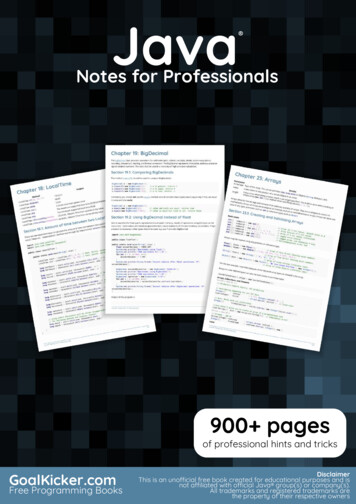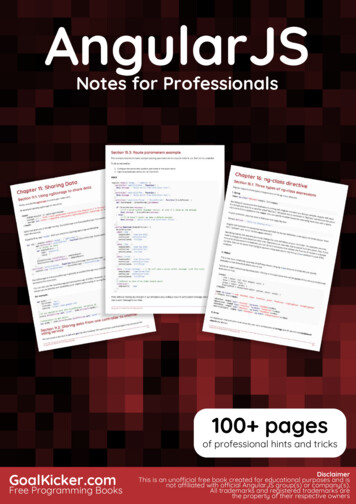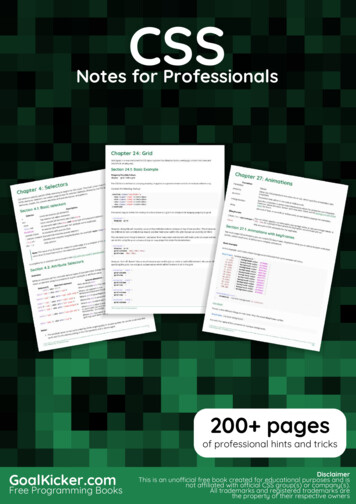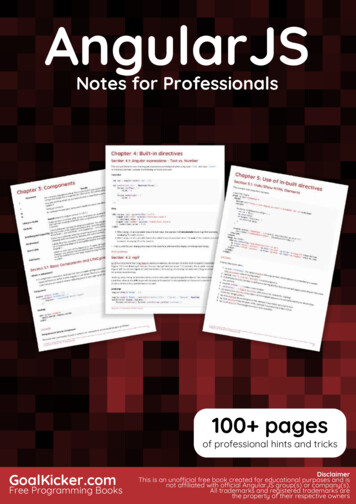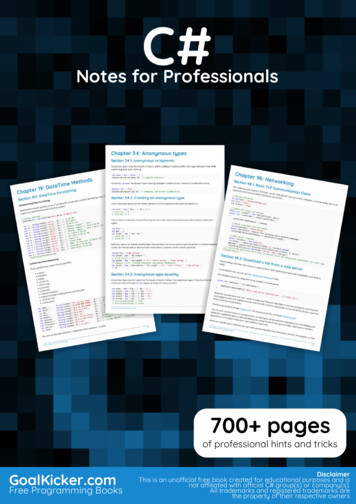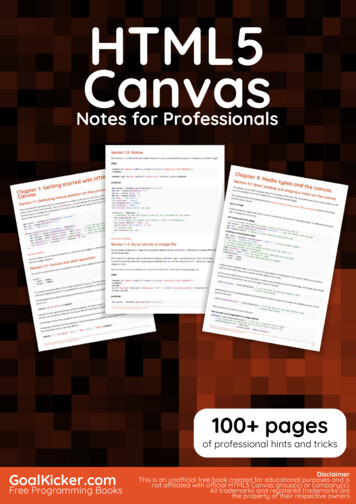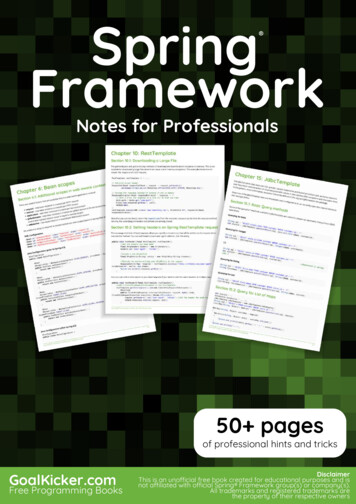
Transcription
SpringFrameworkSpring FrameworkNotes for Professionals Notes for Professionals50 pagesof professional hints and tricksGoalKicker.comFree Programming BooksDisclaimerThis is an uno cial free book created for educational purposes and isnot a liated with o cial Spring Framework group(s) or company(s).All trademarks and registered trademarks arethe property of their respective owners
ContentsAbout . 1Chapter 1: Getting started with Spring Framework . 2Section 1.1: Setup (XML Configuration) . 2Section 1.2: Showcasing Core Spring Features by example . 3Section 1.3: What is Spring Framework, why should we go for it? . 6Chapter 2: Spring Core . 8Section 2.1: Introduction to Spring Core . 8Section 2.2: Understanding How Spring Manage Dependency? . 9Chapter 3: Spring Expression Language (SpEL) . 12Section 3.1: Syntax Reference . 12Chapter 4: Obtaining a SqlRowSet from SimpleJdbcCall . 13Section 4.1: SimpleJdbcCall creation . 13Section 4.2: Oracle Databases . 14Chapter 5: Creating and using beans . 16Section 5.1: Autowiring all beans of a specific type . 16Section 5.2: Basic annotation autowiring . 17Section 5.3: Using FactoryBean for dynamic bean instantiation . 18Section 5.4: Declaring Bean . 19Section 5.5: Autowiring specific bean instances with @Qualifier . 20Section 5.6: Autowiring specific instances of classes using generic type parameters . 21Section 5.7: Inject prototype-scoped beans into singletons . 22Chapter 6: Bean scopes . 25Section 6.1: Additional scopes in web-aware contexts . 25Section 6.2: Prototype scope . 26Section 6.3: Singleton scope . 28Chapter 7: Conditional bean registration in Spring . 30Section 7.1: Register beans only when a property or value is specified . 30Section 7.2: Condition annotations . 30Chapter 8: Spring JSR 303 Bean Validation . 32Section 8.1: @Valid usage to validate nested POJOs . 32Section 8.2: Spring JSR 303 Validation - Customize error messages . 32Section 8.3: JSR303 Annotation based validations in Springs examples . 34Chapter 9: ApplicationContext Configuration . 37Section 9.1: Autowiring . 37Section 9.2: Bootstrapping the ApplicationContext . 37Section 9.3: Java Configuration . 38Section 9.4: Xml Configuration . 40Chapter 10: RestTemplate . 43Section 10.1: Downloading a Large File . 43Section 10.2: Setting headers on Spring RestTemplate request . 43Section 10.3: Generics results from Spring RestTemplate . 44Section 10.4: Using Preemptive Basic Authentication with RestTemplate and HttpClient . 44Section 10.5: Using Basic Authentication with HttpComponent's HttpClient . 46Chapter 11: Task Execution and Scheduling . 47Section 11.1: Enable Scheduling . 47Section 11.2: Cron expression . 47
Section 11.3: Fixed delay . 49Section 11.4: Fixed Rate . 49Chapter 12: Spring Lazy Initialization . 50Section 12.1: Example of Lazy Init in Spring . 50Section 12.2: For component scanning and auto-wiring . 51Section 12.3: Lazy initialization in the configuration class . 51Chapter 13: Property Source . 52Section 13.1: Sample xml configuration using PropertyPlaceholderConfigurer . 52Section 13.2: Annotation . 52Chapter 14: Dependency Injection (DI) and Inversion of Control (IoC) . 53Section 14.1: Autowiring a dependency through Java configuration . 53Section 14.2: Autowiring a dependency through XML configuration . 53Section 14.3: Injecting a dependency manually through XML configuration . 54Section 14.4: Injecting a dependency manually through Java configuration . 56Chapter 15: JdbcTemplate . 57Section 15.1: Basic Query methods . 57Section 15.2: Query for List of Maps . 57Section 15.3: SQLRowSet . 58Section 15.4: Batch operations . 58Section 15.5: NamedParameterJdbcTemplate extension of JdbcTemplate . 59Chapter 16: SOAP WS Consumption . 60Section 16.1: Consuming a SOAP WS with Basic auth . 60Chapter 17: Spring profile . 61Section 17.1: Spring Profiles allows to configure parts available for certain environment . 61Chapter 18: Understanding the dispatcher-servlet.xml . 62Section 18.1: dispatcher-servlet.xml . 62Section 18.2: dispatcher servlet configuration in web.xml . 62Credits . 64You may also like . 65
AboutPlease feel free to share this PDF with anyone for free,latest version of this book can be downloaded s Spring Framework Notes for Professionals book is compiled from StackOverflow Documentation, the content is written by the beautiful people at StackOverflow. Text content is released under Creative Commons BY-SA, see credits atthe end of this book whom contributed to the various chapters. Images may becopyright of their respective owners unless otherwise specifiedThis is an unofficial free book created for educational purposes and is notaffiliated with official Spring Framework group(s) or company(s) nor StackOverflow. All trademarks and registered trademarks are the property of theirrespective company ownersThe information presented in this book is not guaranteed to be correct noraccurate, use at your own riskPlease send feedback and corrections to web@petercv.comGoalKicker.com – Spring Framework Notes for Professionals1
Chapter 1: Getting started with SpringFrameworkVersion Release ection 1.1: Setup (XML Configuration)Steps to create Hello Spring:1. Investigate Spring Boot to see if that would better suit your needs.2. Have a project set up with the correct dependencies. It is recommended that you are using Maven or Gradle.3. create a POJO class, e.g. Employee.java4. create a XML file where you can define your class and variables. e.g beans.xml5. create your main class e.g. Customer.java6. Include spring-beans (and its transitive dependencies!) as a dependency.Employee.java:package com.test;public class Employee {private String name;public String getName() {return name;}public void setName(String name) {this.name name;}public void displayName() om – Spring Framework Notes for Professionals2
?xml version "1.0" encoding "UTF-8"? beans xmlns :xsi emaLocation -4.3.xsd" bean id "employee" class "com.test.Employee" property name "name" value "test spring" /property /bean /beans Customer.java:package com.test;import ort plicationContext;public class Customer {public static void main(String[] args) {ApplicationContext context new ee obj (Employee) ction 1.2: Showcasing Core Spring Features by exampleDescriptionThis is a self-contained running example including/showcasing: minimum dependencies needed, Java Configuration,Bean declaration by annotation and Java Configuration, Dependency Injection by Constructor and by Property, andPre/Post hooks.DependenciesThese dependencies are needed in the classpath:1. spring-core2. spring-context3. spring-beans4. spring-aop5. spring-expression6. commons-loggingMain ClassStarting from the end, this is our Main class that serves as a placeholder for the main() method which initialises theApplication Context by pointing to the Configuration class and loads all the various beans needed to showcaseparticular functionality.package com.stackoverflow.documentation;import lKicker.com – Spring Framework Notes for Professionals3
import onfigApplicationContext;public class Main {public static void main(String[] args) {//initializing the Application Context once per application.ApplicationContext applicationContext new );//bean registered by annotationBeanDeclaredByAnnotation beanDeclaredByAnnotation n registered by Java configuration fileBeanDeclaredInAppConfig beanDeclaredInAppConfig asing constructor injectionBeanConstructorInjection beanConstructorInjection wcasing property injectionBeanPropertyInjection beanPropertyInjection g PreConstruct / PostDestroy hooksBeanPostConstructPreDestroy beanPostConstructPreDestroy ;}}Application Configuration fileThe configuration class is annotated by @Configuration and is used as a parameter in the initialised ApplicationContext. The @ComponentScan annotation at the class level of the configuration class points to a package to bescanned for Beans and dependencies registered using annotations. Finally the @Bean annotation serves as a beandefinition in the configuration class.package com.stackoverflow.documentation;import org.springframework.context.annotation.Bean;import an;import .documentation")public class AppConfig {@Beanpublic BeanDeclaredInAppConfig beanDeclaredInAppConfig() {return new BeanDeclaredInAppConfig();}GoalKicker.com – Spring Framework Notes for Professionals4
}Bean Declaration by AnnotationThe @Component annotation serves to demarcate the POJO as a Spring bean available for registration duringcomponent scanning.@Componentpublic class BeanDeclaredByAnnotation {public void sayHello() {System.out.println("Hello, World from BeanDeclaredByAnnotation !");}}Bean Declaration by Application ConfigurationNotice that we don't need to annotate or otherwise mark our POJO since the bean declaration/definition ishappening in the Application Configuration class file.public class BeanDeclaredInAppConfig {public void sayHello() {System.out.println("Hello, World from BeanDeclaredInAppConfig !");}}Constructor InjectionNotice that the @Autowired annotation is set at the constructor level. Also notice that unless explicitely defined byname the default autowiring is happening based on the type of the bean (in this instance BeanToBeInjected).package com.stackoverflow.documentation;import ired;import tpublic class BeanConstructorInjection {private BeanToBeInjected dependency;@Autowiredpublic BeanConstructorInjection(BeanToBeInjected dependency) {this.dependency dependency;}public void sayHello() {System.out.print("Hello, World from BeanConstructorInjection with dependency: ");dependency.sayHello();}}Property InjectionNotice that the @Autowired annotation demarcates the setter method whose name follows the JavaBeans standard.GoalKicker.com – Spring Framework Notes for Professionals5
package com.stackoverflow.documentation;import ired;import tpublic class BeanPropertyInjection {private BeanToBeInjected dependency;@Autowiredpublic void setBeanToBeInjected(BeanToBeInjected beanToBeInjected) {this.dependency beanToBeInjected;}public void sayHello() {System.out.println("Hello, World from BeanPropertyInjection !");}}PostConstruct / PreDestroy hooksWe can intercept initialisation and destruction of a Bean by the @PostConstruct and @PreDestroy hooks.package com.stackoverflow.documentation;import org.springframework.stereotype.Component;import javax.annotation.PostConstruct;import javax.annotation.PreDestroy;@Componentpublic class BeanPostConstructPreDestroy {@PostConstructpublic void pre() {System.out.println("BeanPostConstructPreDestroy - PostConstruct");}public void sayHello() {System.out.println(" Hello World, BeanPostConstructPreDestroy !");}@PreDestroypublic void post() {System.out.println("BeanPostConstructPreDestroy - PreDestroy");}}Section 1.3: What is Spring Framework, why should we go forit?Spring is a framework, which provides bunch of classes, by using this we don't need to write boiler plate logic in ourcode, so Spring provides an abstract layer on J2ee.For Example in Simple JDBC Application programmer is responsible for1. Loading the driver classGoalKicker.com – Spring Framework Notes for Professionals6
2. Creating the connection3. Creating statement object4. Handling the exceptions5. Creating query6. Executing query7. Closing the connectionWhich is treated as boilerplate code as every programmer write the same code. So for simplicity the frameworktakes care of boilerplate logic and the programmer has to write only business logic. So by using Spring frameworkwe can develop projects rapidly with minimum lines of code, without any bug, the development cost and time alsoreduced.So Why to choose Spring as struts is thereStrut is a framework which provide solution to web aspects only and struts is invasive in nature. Spring has manyfeatures over struts so we have to choose Spring.1. Spring is Noninvasive in nature: That means you don't need to extend any classes or implement anyinterfaces to your class.2. Spring is versatile: That means it can integrated with any existing technology in your project.3. Spring provides end to end project development: That means we can develop all the modules like businesslayer, persistence layer.4. Spring is light weight: That means if you want to work on particular module then , you don't need to learncomplete spring, only learn that particular module(eg. Spring Jdbc, Spring DAO)5. Spring supports dependency injection.6. Spring supports multiple project development eg: Core java Application, Web Application, DistributedApplication, Enterprise Application.7. Spring supports Aspect oriented Programming for cross cutting concerns.So finally we can say Spring is an alternative to Struts. But Spring is not a replacement of J2EE API, As Springsupplied classes internally uses J2EE API classes. Spring is a vast framework so it has divided into several modules.No module is dependent to another except Spring Core. Some Important modules are1. Spring Core2. Spring JDBC3. Spring AOP4. Spring Transaction5. Spring ORM6. Spring MVCGoalKicker.com – Spring Framework Notes for Professionals7
Chapter 2: Spring CoreSection 2.1: Introduction to Spring CoreSpring is a vast framework, so the Spring framework has been divided in several modules which makes springlightweight. Some important modules are:1. Spring Core2. Spring AOP3. Spring JDBC4. Spring Transaction5. Spring ORM6. Spring MVCAll the modules of Spring are independent of each other except Spring Core. As Spring core is the base module, soin all module we have to use Spring CoreSpring CoreSpring Core talking all about dependency management.That means if any arbitrary classes provided to spring thenSpring can manage dependency.What is a dependency:From project point of view, in a project or application multiple classes are there with different functionality. andeach classes required some functionality of other classes.Example:class Engine {public void start() {System.out.println("Engine started");}}class Car {public void move() {// For moving start() method of engine class is required}}Here class Engine is required by class car so we can say class engine is dependent to class Car, So instead of wemanaging those dependency by Inheritance or creating object as fallows.By Inheritance:class Engine {public void start() {System.out.println("Engine started");}}class Car extends Engine {GoalKicker.com – Spring Framework Notes for Professionals8
public void move() {start(); //Calling super class start method,}}By creating object of dependent class:class Engine {public void start() {System.out.println("Engine started");}}class Car {Engine eng new Engine();public void move() {eng.start();}}So instead of we managing dependency between classes spring core takes the responsibility dependencymanagement. But Some rule are there, The classes must be designed with some design technique that is Strategydesign pattern.Section 2.2: Understanding How Spring Manage Dependency?Let me write a piece of code which shows completely loosely coupled, Then you can easily understand how Springcore manage the dependency internally. Consider an scenario, Online business Flipkart is there, it uses some timesDTDC or Blue Dart courier service , So let me design a application which shows complete loosely coupled. TheEclipse Directory as fallows://Interfacepackage com.sdp.component;public interface Courier {public String deliver(String iteams,String address);}GoalKicker.com – Spring Framework Notes for Professionals9
//implementation classespackage com.sdp.component;public class BlueDart implements Courier {public String deliver(String iteams, String address) {return iteams "Shiped to Address " address "Through BlueDart";}}package com.sdp.component;public class Dtdc implements Courier {public String deliver(String iteams, String address) {return iteams "Shiped to Address " address "Through Dtdc";}}//Component classepackage com.sdp.service;import com.sdp.component.Courier;public class FlipKart {private Courier courier;public void setCourier(Courier courier) {this.courier courier;}public void shopping(String iteams,String address){String status courier.deliver(iteams, address);System.out.println(status);}}//Factory classes to create and return Objectpackage com.sdp.util;import java.io.IOException;import java.util.Properties;import com.sdp.component.Courier;public class ObjectFactory {private static Properties props;static{props new Properties();try {GoalKicker.com – Spring Framework Notes for Professionals10
s"));} catch (IOException e) {// TODO Auto-generated catch blocke.printStackTrace();}}public static Object getInstance(String logicalclassName){Object obj null;String originalclassName props.getProperty(logicalclassName);try {obj Class.forName(originalclassName).newInstance();} catch (InstantiationException e) {// TODO Auto-generated catch blocke.printStackTrace();} catch (IllegalAccessException e) {// TODO Auto-generated catch blocke.printStackTrace();} catch (ClassNotFoundException e) {// TODO Auto-generated catch blocke.printStackTrace();}return obj;}}//properties fileBlueDart.class com.sdp.component.BlueDartDtdc.class com.sdp.component.DtdcFlipKart.class com.sdp.service.FlipKart//Test classpackage com.sdp.test;import com.sdp.component.Courier;import com.sdp.service.FlipKart;import com.sdp.util.ObjectFactory;public class FlipKartTest {public static void main(String[] args) {Courier courier lipKart flipkart ("Hp Laptop", "SR Nagar,Hyderabad");}}If we write this code then we can manually achieve loose coupling,this is applicable if all the classes want eitherBlueDart or Dtdc , But if some class want BlueDart and some other class want Dtdc then again it will be tightlycoupled, So instead of we creating and managing the dependency injection Spring core takes the responsibility ofcreating and managing the beans, Hope This will helpful, in next example we wil see the !st application on Springcore with deitalsGoalKicker.com – Spring Framework Notes for Professionals11
Chapter 3: Spring Expression Language(SpEL)Section 3.1: Syntax ReferenceYou can use @Value("#{expression}") to inject value at runtime, in which the expression is a SpEL expression.Literal expressionsSupported types include strings, dates, numeric values (int, real, and hex), boolean and null."#{'Hello /numeric values (double)//boolean//nullInline list"#{1,2,3,4}""#{{'a','b'},{'x','y'}}"//list of number//list of listInline ly',year:1856}}" //map of mapsInvoking Methods"#{'abc'.length()}"//evaluates to 3"#{f('hello')}"//f is a method in the class to which this expression belongs, it has a stringparameterGoalKicker.com – Spring Framework Notes for Professionals12
Chapter 4: Obtaining a SqlRowSet fromSimpleJdbcCallThis describes how to directly obtain a SqlRowSet using SimpleJdbcCall with a stored procedure in your databasethat has a cursor output parameter,I am working with an Oracle database, I've attempted to create an example that should work for other databases,my Oracle example details issues with Oracle.Section 4.1: SimpleJdbcCall creationTypically, you will want to create your SimpleJdbcCalls in a Service.This example assumes your procedure has a single output parameter that is a cursor; you will need to adjust yourdeclareParameters to match your procedure.@Servicepublic class MyService() {@Autowiredprivate DataSource dataSource;// Autowire your configuration, for example@Value(" {db.procedure.schema}")String schema;private SimpleJdbcCall myProcCall;// create SimpleJdbcCall after properties are configured@PostConstructvoid initialize() {this.myProcCall new SimpleJdbcCall(dataSource).withProcedureName("my procedure name").withCatalogName("my (new SqlOutParameter("out param name",Types.REF CURSOR,new SqlRowSetResultSetExtractor()));}public SqlRowSet myProc() {Map String, Object out this.myProcCall.execute();return (SqlRowSet) out.get("out param name");}}There are many options you can use here:withoutProcedureColumnMetaDataAccess() needed if you have overloaded procedure names or justdon't want SimpleJdbcCall to validate against the database.withReturnValue() if procedure has a return value. First value given to declareParameters defines thereturn value. Also, if your procedure is a function, use withF
This is a self-contained running example including/showcasing: minimum dependencies needed, Java Configuration, Bean declaration by annotation and Java Configuration, Dependency Injection by Constructor and by Property, and Pre/Post hooks. Dependencies These dependencies are needed in the




